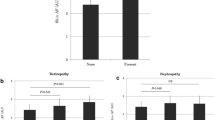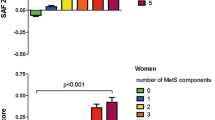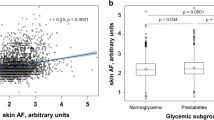Abstract
Purpose
Advanced glycation end product (AGE) is a marker of metabolic memory. Accumulated AGEs in skin collagen measured with skin autofluorescence (SAF) was found to be associated with subclinical atherosclerosis. We aimed to evaluate SAF and carotid intima-media thickness (CIMT) and its association with clinical and biochemical parameters in severely obese patients before and after bariatric surgery.
Materials and Methods
In this observational study, 432 morbid obese patients evaluated before and after 6 and 12 months of bariatric surgery for metabolic and anthropometric parameters, CIMT and SAF. SAF was assessed in the forearm with an AGE Reader.
Results
SAF measurements were higher in diabetic (2.04 ± 0.52 AU) obese patients compared to non-diabetic (1.78 ± 0.40 AU) obese patients (p < 0.0001). Although bariatric surgery-induced weight loss resulted in a decrease in CIMT in the 6th and 12th months compared to baseline, weight loss and metabolic improvements were not associated with a parallel decrease in SAF measurements. SAF measurements were positively correlated with body mass index (r 0.527, p < 0.0001), HbA1c (r 0.362, p < 0.0001), and CIMT (r 0.319, p < 0.0001). Multivariate analysis showed the presence of diabetes (but not BMI, age, and sex) was independently associated with SAF (R2 = 7.62%), and the presence of diabetes, low-density cholesterol, and systolic blood pressure were independently associated with CIMT measurements (R2 = 21.7%).
Conclusion
Bariatric surgery-induced weight loss and metabolic improvement were found to be associated with improvement in CIMT, while skin AGE accumulation was not regressed in the first year of surgery.
Similar content being viewed by others
References
Goldin A, Beckman JA, Schmidt AM, et al. Advanced glycation end products: sparking the development of diabetic vascular injury. Circulation. 2006;114(6):597–605.
Meerwaldt R, Hartog JW, Graaff R, et al. Skin autofluorescence, a measure of cumulative metabolic stress and advanced glycation end products, predicts mortality in hemodialysis patients. J Am Soc Nephrol. 2005;16(12):3687–93.
Dina R, Vladu I, Dina C, Mitrea A. Advanced glycation end products measured by AGE Reader in a group of patients with obesity. Romanian Journal of Diabetes Nutrition and Metabolic Diseases 2012 01/01;19.
Gerrits EG, Lutgers HL, Kleefstra N, et al. Skin autofluorescence: a tool to identify type 2 diabetic patients at risk for developing microvascular complications. Diabetes Care. 2008;31(3):517–21.
Lutgers HL, Graaff R, Links TP, et al. Skin autofluorescence as a noninvasive marker of vascular damage in patients with type 2 diabetes. Diabetes Care. 2006;29(12):2654–9.
Meerwaldt R, Lutgers HL, Links TP, et al. Skin autofluorescence is a strong predictor of cardiac mortality in diabetes. Diabetes Care. 2007;30(1):107–12.
den Engelsen C, van den Donk M, Gorter KJ, et al. Advanced glycation end products measured by skin autofluorescence in a population with central obesity. Dermato-Endocrinology. 2012;4(1):33–8.
Evans JL, Goldfine ID, Maddux BA, et al. Are oxidative stress-activated signaling pathways mediators of insulin resistance and beta-cell dysfunction? Diabetes. 2003;52(1):1–8.
Tahara N, Yamagishi S, Matsui T, et al. Serum levels of advanced glycation end products (AGEs) are independent correlates of insulin resistance in nondiabetic subjects. Cardiovasc Ther. 2012;30(1):42–8.
Gkogkolou P, Bohm M. Advanced glycation end products: key players in skin aging? Dermatoendocrinol. 2012;4(3):259–70.
Da Moura SC, Webb M, Waller H, et al. Skin autofluorescence, a non-invasive marker of advanced glycation end products: clinical relevance and limitations. Postgrad Med J. 2017;93(1099):289–94.
Sanchez E, Baena-Fustegueras JA, de la Fuente MC, et al. Advanced glycation end-products in morbid obesity and after bariatric surgery: when glycemic memory starts to fail. Endocrinol Diabetes Nutr. 2017;64(1):4–10. Productos finales de glicacion avanzada en la obesidad morbida y tras la cirugia bariatrica: cuando la memoria glucemica empieza a fallar
Brix JM, Hollerl F, Kopp HP, et al. The soluble form of the receptor of advanced glycation endproducts increases after bariatric surgery in morbid obesity. Int J Obes. 2012;36(11):1412–7. Epub 2012/07/26
Tavares JF, Ribeiro PVM, Coelho OGL, Silva LED, Alfenas RCG. Can advanced glycation end-products and their receptors be affected by weight loss? A systematic review. Obes Rev. 2020
Lutgers HL, Graaff R, de Vries R, et al. Carotid artery intima media thickness associates with skin autofluoresence in non-diabetic subjects without clinically manifest cardiovascular disease. Eur J Clin Investig. 2010 Sep;40(9):812–7.
Grundy SM, Cleeman JI, Daniels SR, et al. Diagnosis and management of the metabolic syndrome: an American Heart Association/National Heart, Lung, and Blood Institute scientific statement. Circulation. 2005;112(17):2735–52.
American DA. 2. Classification and diagnosis of diabetes. Diabetes Care. 2017;40(Suppl 1):S11–24.
Meerwaldt R, Graaff R, Oomen PHN, et al. Simple non-invasive assessment of advanced glycation endproduct accumulation. Diabetologia. 2004;47(7):1324–30.
Koetsier M, Lutgers HL, de Jonge C, et al. Reference values of skin autofluorescence. Diabetes Technol Ther. 2010;12(5):399–403.
Stein JH. Carotid intima-media thickness and vascular age: you are only as old as your arteries look. J Am Soc Echocardiogr. 2004;17(6):686–9.
Stein JH, Korcarz CE, Hurst RT, et al. Use of carotid ultrasound to identify subclinical vascular disease and evaluate cardiovascular disease risk: a consensus statement from the American Society of Echocardiography Carotid Intima-Media Thickness Task Force. Endorsed by the Society for Vascular Medicine. J Am Soc Echocardiogr. 2008;21(2):93–111. quiz 89-90
Arkin JM, Alsdorf R, Bigornia S, et al. Relation of cumulative weight burden to vascular endothelial dysfunction in obesity. Am J Cardiol. 2008;101(1):98–101.
Lupoli R, Di Minno MN, Guidone C, et al. Effects of bariatric surgery on markers of subclinical atherosclerosis and endothelial function: a meta-analysis of literature studies. Int J Obes. 2016;40(3):395–402.
Celik F, Graaff R, Ahdi M, et al. Bariatric surgery: studies on its consequences with emphasis on thrombotic and bleeding complications. University of Amsterdam; 2014. https://hdl.handle.net/11245/1.432090.
Verzijl N, DeGroot J, Thorpe SR, et al. Effect of collagen turnover on the accumulation of advanced glycation end products. J Biol Chem. 2000 Dec 15;275(50):39027–31.
Lorenz MW, Markus HS, Bots ML, et al. Prediction of clinical cardiovascular events with carotid intima-media thickness: a systematic review and meta-analysis. Circulation. 2007;115(4):459–67.
Smith Jr SC, Greenland P, Grundy SM. AHA Conference Proceedings. Prevention conference V: beyond secondary prevention: identifying the high-risk patient for primary prevention: executive summary. American Heart Association. Circulation. 2000;101(1):111–6.
Mancia G, Fagard R, Narkiewicz K, et al. 2013 ESH/ESC guidelines for the management of arterial hypertension: the Task Force for the Management of Arterial Hypertension of the European Society of Hypertension (ESH) and of the European Society of Cardiology (ESC). Eur Heart J. 2013;34(28):2159–219.
Lorenz MW, Polak JF, Kavousi M, et al. Carotid intima-media thickness progression to predict cardiovascular events in the general population (the PROG-IMT collaborative project): a meta-analysis of individual participant data. Lancet. 2012;379(9831):2053–62.
Sturm W, Tschoner A, Engl J, et al. Effect of bariatric surgery on both functional and structural measures of premature atherosclerosis. Eur Heart J. 2009;30:2038–43.
Garcia G, Bunout D, Mella J, et al. Bariatric surgery decreases carotid intima-media thickness in obese subjects. Nutr Hosp. 2013;28(4):1102–8.
Sarmento P, Plavnik F, Zanella M, et al. Association of carotid intima-media thickness and cardiovascular risk factors in women pre- and post-bariatric surgery. Obes Surg. 2008;19:339–44.
Altin C, Erol V, Aydin E, et al. Impact of weight loss on epicardial fat and carotid intima media thickness after laparoscopic sleeve gastrectomy: a prospective study. Nutr Metab Cardiovasc Dis. 2018;28(5):501–9.
Elitok A, Emet S, Bayramov F, et al. Effect of bariatric surgery on flow-mediated dilation and carotid intima-media thickness in patients with morbid obesity: 1-year follow-up study. Anatol J Cardiol. 2020;23(4):218–22.
Habib P, Scrocco JD, Terek M, et al. Effects of bariatric surgery on inflammatory, functional and structural markers of coronary atherosclerosis. Am J Cardiol. 2009;104(9):1251–5.
Mavri A, Stegnar M, Sentocnik JT, et al. Impact of weight reduction on early carotid atherosclerosis in obese premenopausal women. Obes Res. 2001;9(9):511–6.
Lundby-Christensen L, Tarnow L, Hansen DL, et al. Carotid intima-media thickness is reduced 12 months after gastric bypass surgery in obese patients with type 2 diabetes or impaired glucose tolerance. J Diabetes Complicat. 2014;28(4):517–22.
Tromba L, Tartaglia F, Carbotta S, et al. The role of sleeve Gastrectomy in reducing cardiovascular risk. Obes Surg. 2017;27(5):1145–51.
Jonker FHW, van Houten VAA, Wijngaarden LH, et al. Age-related effects of bariatric surgery on early atherosclerosis and cardiovascular risk reduction. Obes Surg. 2018;28(4):1040–6.
Leeman M, van Mil SR, Al-Ghanam I, et al. Structural and functional vascular improvement 1 year after bariatric surgery: a prospective cohort study. Surg Obes Relat Dis. 2019;15(10):1773–9.
Author information
Authors and Affiliations
Contributions
All authors made substantial contributions to conception and design, and/or acquisition of data, and/or analysis and interpretation of data, participated in drafting the article or revising it critically for important intellectual content, and gave final approval of the version to be submitted.
Corresponding author
Ethics declarations
Conflict of Interest
The authors declare that they have no conflict of interest.
Ethical Approval
All procedures performed in studies involving human participants were in accordance with ethical standards of the institutional research committee and with the 1964 Helsinki declaration and its later amendments or comparable ethical standards.
Informed Consent
Informed consent was obtained from all individual participants included in the study.
Additional information
Publisher’s Note
Springer Nature remains neutral with regard to jurisdictional claims in published maps and institutional affiliations.
Rights and permissions
About this article
Cite this article
Gogas Yavuz, D., Apaydin, T., Imre, E. et al. Skin Autofluorescence and Carotid Intima-Media Thickness Evaluation Following Bariatric Surgery in Patients with Severe Obesity. OBES SURG 31, 1055–1061 (2021). https://doi.org/10.1007/s11695-020-05077-z
Received:
Revised:
Accepted:
Published:
Issue Date:
DOI: https://doi.org/10.1007/s11695-020-05077-z




